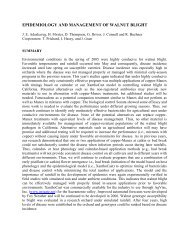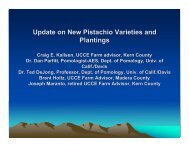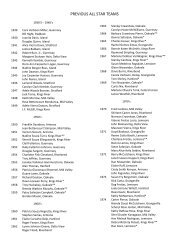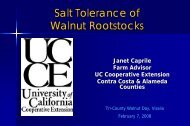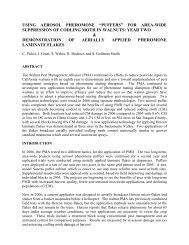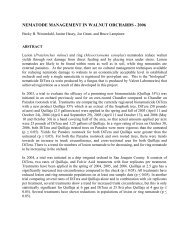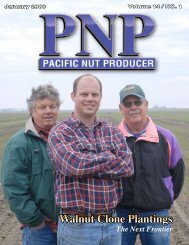Terminology and Characteristics of New Walnut Plant Material
Terminology and Characteristics of New Walnut Plant Material
Terminology and Characteristics of New Walnut Plant Material
You also want an ePaper? Increase the reach of your titles
YUMPU automatically turns print PDFs into web optimized ePapers that Google loves.
<strong>Walnut</strong> Trees in the Nursery Trade:<br />
Underst<strong>and</strong>ing <strong>Terminology</strong>, How they are Propagated,<br />
Availability <strong>and</strong> Clonal Rootstock Pest Interactions<br />
Janine Hasey, Chuck Leslie, Wesley Hackett, Gale McGranahan, Michael McKenry, Greg Browne, Dan Kluepfel<br />
Helpful <strong>Terminology</strong> in Underst<strong>and</strong>ing <strong>Walnut</strong> <strong>Plant</strong> <strong>Material</strong><br />
Cultivar (cultivated variety) - A named group <strong>of</strong> plants within a cultivated species that is distinguished by a<br />
group <strong>of</strong> characteristics, e.g. refers to a vegetatively propagated clone, such as ‘Ch<strong>and</strong>ler’ or<br />
‘Howard’<br />
Genotype - The genetic constitution <strong>of</strong> an individual.<br />
Phenotype - An individual’s observable characteristics or traits, e.g. flower color, or nut size.<br />
Clone - <strong>Plant</strong>s (scion or rootstock) reproduced from a single plant by vegetative methods (grafting, cuttings,<br />
layering, micropropagation). <strong>Plant</strong>s produced in this manner have the same genotype as the parent.<br />
Variation can exist among clones from a given plant due to their interaction with the environment.<br />
Micropropagation- Multiplication <strong>of</strong> plants under sterile in vitro conditions in a lab followed by hardening <strong>of</strong>f<br />
in a greenhouse. Most <strong>of</strong> the clonal rootstock <strong>and</strong> own-rooted walnut plant material in the trade is<br />
micropropagated.<br />
Grafted or budded plant - A plant whose roots are <strong>of</strong> one genotype <strong>and</strong> the shoots (scion) are <strong>of</strong> a different<br />
genotype, obtained by grafting or budding a cultivar onto a rootstock.<br />
Own-rooted (also known as self-rooted) plant - A plant whose roots are <strong>of</strong> the same genotype as the shoots. It<br />
is obtained by micropropagation or rooting stem cuttings.<br />
Seedling - A plant propagated from seed.<br />
<strong>Plant</strong>let – A plant propagated by vegetative methods e.g. micropropagation.<br />
Liner – A young rooted plant used for transplanting into a nursery row or larger container.<br />
A walnut plant can be purchased as a:<br />
‣ Rootstock - A seedling or clonally produced tree, to be subsequently field grafted or budded to the<br />
desired English variety (cultivar). Until recently, most rootstocks have been seedlings: Seedling black,<br />
seedling Paradox hybrid (black x English), seedling English (no longer available). Clonal Paradox<br />
rootstocks with selected characteristics are now favored by many growers <strong>and</strong> are available from many<br />
nurseries. They are sold as potted plants or bare root trees.<br />
‣ Two-year old tree – A two-year nursery product where the rootstock grows for a year <strong>and</strong> the cultivar<br />
(English variety scion) grows for a year in the nursery. Nurseries can either bud the rootstock in the fall<br />
<strong>of</strong> year one or graft the rootstock in the spring <strong>of</strong> year two.<br />
‣ June-budded tree – A one-year old tree with the English variety budded onto the rootstock at the<br />
nursery in the spring or early summer. The nursery tree will be much smaller than a two-year tree,<br />
however, research <strong>and</strong> experience have shown that the grower’s orchard tree at the end <strong>of</strong> the first<br />
growing season can be as large as or larger than a two-year tree.<br />
http://walnutresearch.ucdavis.edu/1996/1996_71.pdf.<br />
‣ Own-rooted (also known as self-rooted) tree – An English variety rooted <strong>and</strong> grown on its own roots<br />
until ready for orchard planting. There is no graft or bud union.
Availability in Nursery Trade<br />
Rootstocks (sold as ungrafted or unbudded trees): Seedling Paradox, seedling black, or clonal Paradox<br />
‘Vlach’, ‘VX211’, or ‘RX1’ (<strong>and</strong> possibly other clonal rootstocks).<br />
‣ Clonal rootstocks are sold as potted plants or bare root trees.<br />
Nursery Grafted or Budded Trees: Various English varieties on seedling Paradox, seedling black, or clonal<br />
Paradox ‘Vlach’, ‘VX211’, or ‘RX1’ (<strong>and</strong> possibly other clonal rootstocks) sold as bare root trees.<br />
Own-Rooted English Trees: ‘Ch<strong>and</strong>ler’ available in 2014. ‘Howard’, ‘Tulare’, or ‘Serr’ available by custom<br />
order (one year advance notice required for large quantities).<br />
<strong>Characteristics</strong> <strong>of</strong> available clonal Paradox walnut rootstocks based on available data 1<br />
Trait <strong>of</strong> interest ‘Vlach’ ‘VX211’ ‘RX1’<br />
Rootstock Vigor 2 Vigorous Highly Moderately<br />
vigorous vigorous<br />
Resistance to Phytophthora citricola<br />
(a cause <strong>of</strong> crown <strong>and</strong> root rot)<br />
Resistance to Phytophthora cinnamomi<br />
(a cause <strong>of</strong> root <strong>and</strong> crown rot)<br />
LR MR MR-HR<br />
LR LR HR<br />
Resistance to Agrobacterium tumefaciens<br />
LR LR MR<br />
(cause <strong>of</strong> crown gall)<br />
LR = low resistance MR = moderate resistance HR=high resistance<br />
Root Knot Nematode S-IT S-ST<br />
Root Lesion Nematode HS-IT S-ST 3 S-IT<br />
(Pratylenchus vulnus)<br />
Nematode’s ability to reproduce HS = highly susceptible<br />
S = susceptible<br />
Tree response to nematode ST = some tree tolerance<br />
to nematode presence<br />
IT = tree intolerant to<br />
nematode presence, i.e.<br />
reduced tree vigor/health in<br />
presence <strong>of</strong> nematode<br />
1 Based on data from ongoing UC <strong>and</strong> USDA-ARS trials<br />
2 In field trials with grafted trees, the vigor <strong>of</strong> the rootstock isn't necessarily reflected in the vigor <strong>of</strong> the scion, e.g. sometimes<br />
grafted trees on RX1 <strong>and</strong> Vlach are more vigorous than on VX211.<br />
3 Nematode tolerance due to a post-infection resistance mechanism<br />
Revised February 25, 2014



